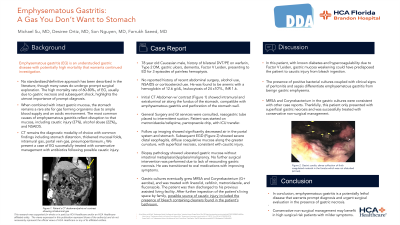Sunday Poster Session
Category: Stomach
P1380 - Emphysematous Gastritis: A Gas You Don't Want to Stomach
Sunday, October 22, 2023
3:30 PM - 7:00 PM PT
Location: Exhibit Hall

Has Audio

Michael Su, MD
HCA West Florida
Riverview, FL
Presenting Author(s)
Michael Su, MD1, Farrukh Saeed, MD2
1HCA West Florida, Brandon, FL; 2Digestive Disease Associates of Tampa Bay, Brandon, FL
Introduction: Emphysematous gastritis (EG) is an understudied gastric disease with potentially high mortality. No standardized/definitive approach has been described in the literature, though many cases do undergo prompt surgical exploration. We present a case of EG successfully treated with conservative management with antibiotics following possible caustic injury.
Case Description/Methods: 78 year old Caucasian male, history of bilateral DVT/PE on warfarin status post IVC filter, Type 2 DM, dementia, Factor V Leiden, presenting for painless hemoptysis. There was no reported history of recent abdominal surgery, alcohol use, NSAIDS, or corticosteroid use. He presented to ED with stable hemoglobin, leukocytosis of 24 x 109/L, thrombocytosis of 471 x 109/L, INR 1.6. Initial CT Abdomen w/ contrast showed air within the stomach wall and extraluminal air along the fundus, compatible with EG and stomach wall perforation. Portal venous air within the liver was also present. Surgical and GI services were consulted due to suspected stomach ischemia/infarction. Patient was started on Flagyl/Cefepime/Fluconazole, Protonix drip, NG tube placed, and transferred to the ICU.
A subsequent CT showed significantly decreased air in the portal system and stomach. EGD showed diffuse coagulative mucosa mostly in the fundus and proximal body of the stomach along the greater curvature, with small areas of superficial necrosis, consistent with caustic injury. Gastric aspirates culture grew MRSA and corynebacterium. Biopsy showed ulcerated gastric mucosa without intestinal malignancy. Surgery was deferred due to lack of resounding gastric necrosis.
The patient was then discharged to his facility after clinical improvement. Further inspection of living space revealed bleach containing cleaners as a possible source of caustic injury.
Discussion: The stomach is an unusual site for gas gangrene due to its ample blood supply and acidic environment. The most common causes of EG reflect mucosal disruption. In this patient with known DM and Factor V Leiden, mucosal weakening likely predisposed him to caustic injury.
EG is a potentially lethal disease that warrants prompt diagnosis and urgent surgical evaluation. Thankfully, our patient presented with superficial necrosis and was successfully treated with conservative non-surgical management. In conclusion, medical management for EG can be considered in the setting of inherent surgical risk and significant clinical improvement.
Disclosures:
Michael Su, MD1, Farrukh Saeed, MD2. P1380 - Emphysematous Gastritis: A Gas You Don't Want to Stomach, ACG 2023 Annual Scientific Meeting Abstracts. Vancouver, BC, Canada: American College of Gastroenterology.
1HCA West Florida, Brandon, FL; 2Digestive Disease Associates of Tampa Bay, Brandon, FL
Introduction: Emphysematous gastritis (EG) is an understudied gastric disease with potentially high mortality. No standardized/definitive approach has been described in the literature, though many cases do undergo prompt surgical exploration. We present a case of EG successfully treated with conservative management with antibiotics following possible caustic injury.
Case Description/Methods: 78 year old Caucasian male, history of bilateral DVT/PE on warfarin status post IVC filter, Type 2 DM, dementia, Factor V Leiden, presenting for painless hemoptysis. There was no reported history of recent abdominal surgery, alcohol use, NSAIDS, or corticosteroid use. He presented to ED with stable hemoglobin, leukocytosis of 24 x 109/L, thrombocytosis of 471 x 109/L, INR 1.6. Initial CT Abdomen w/ contrast showed air within the stomach wall and extraluminal air along the fundus, compatible with EG and stomach wall perforation. Portal venous air within the liver was also present. Surgical and GI services were consulted due to suspected stomach ischemia/infarction. Patient was started on Flagyl/Cefepime/Fluconazole, Protonix drip, NG tube placed, and transferred to the ICU.
A subsequent CT showed significantly decreased air in the portal system and stomach. EGD showed diffuse coagulative mucosa mostly in the fundus and proximal body of the stomach along the greater curvature, with small areas of superficial necrosis, consistent with caustic injury. Gastric aspirates culture grew MRSA and corynebacterium. Biopsy showed ulcerated gastric mucosa without intestinal malignancy. Surgery was deferred due to lack of resounding gastric necrosis.
The patient was then discharged to his facility after clinical improvement. Further inspection of living space revealed bleach containing cleaners as a possible source of caustic injury.
Discussion: The stomach is an unusual site for gas gangrene due to its ample blood supply and acidic environment. The most common causes of EG reflect mucosal disruption. In this patient with known DM and Factor V Leiden, mucosal weakening likely predisposed him to caustic injury.
EG is a potentially lethal disease that warrants prompt diagnosis and urgent surgical evaluation. Thankfully, our patient presented with superficial necrosis and was successfully treated with conservative non-surgical management. In conclusion, medical management for EG can be considered in the setting of inherent surgical risk and significant clinical improvement.
Disclosures:
Michael Su indicated no relevant financial relationships.
Farrukh Saeed indicated no relevant financial relationships.
Michael Su, MD1, Farrukh Saeed, MD2. P1380 - Emphysematous Gastritis: A Gas You Don't Want to Stomach, ACG 2023 Annual Scientific Meeting Abstracts. Vancouver, BC, Canada: American College of Gastroenterology.
